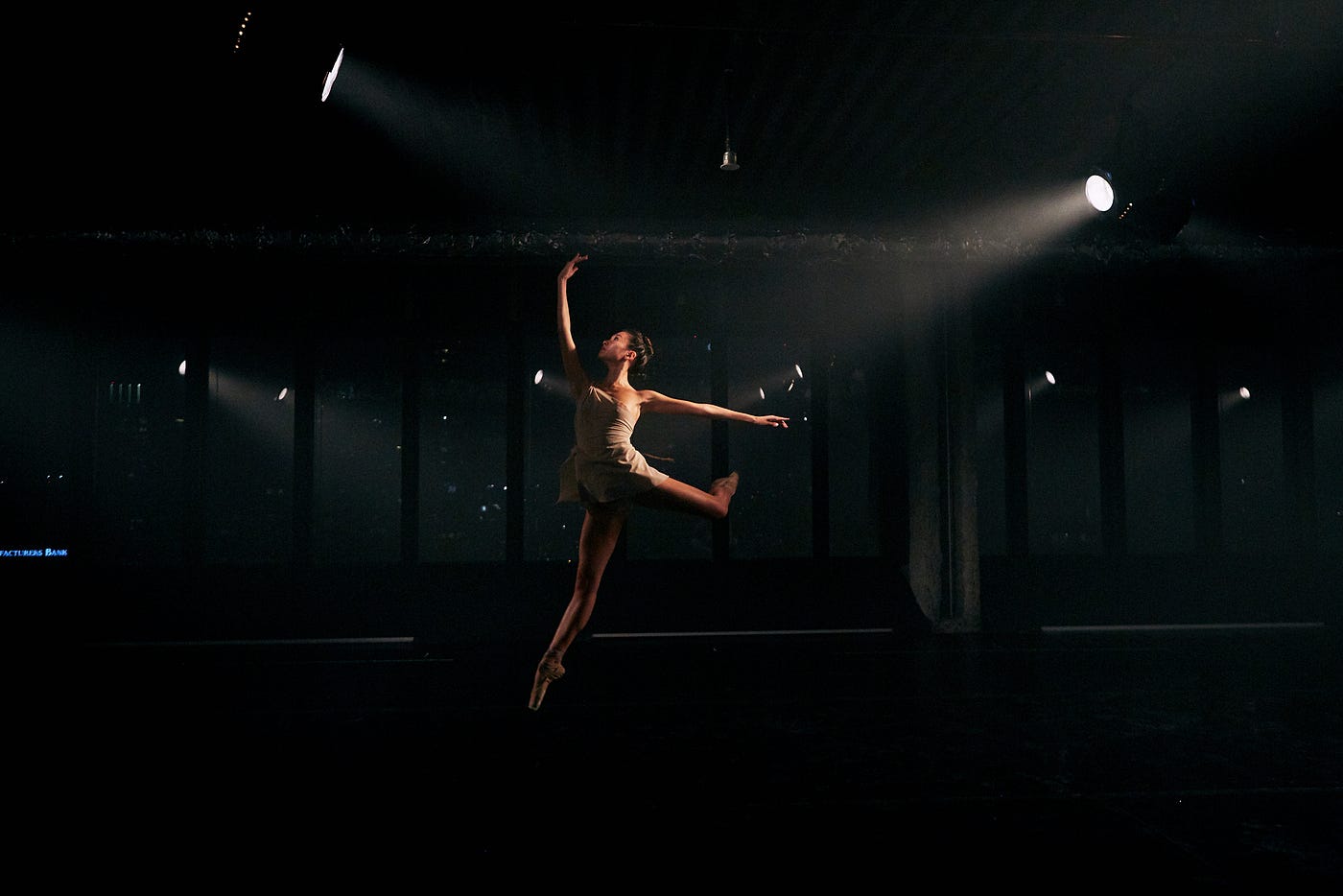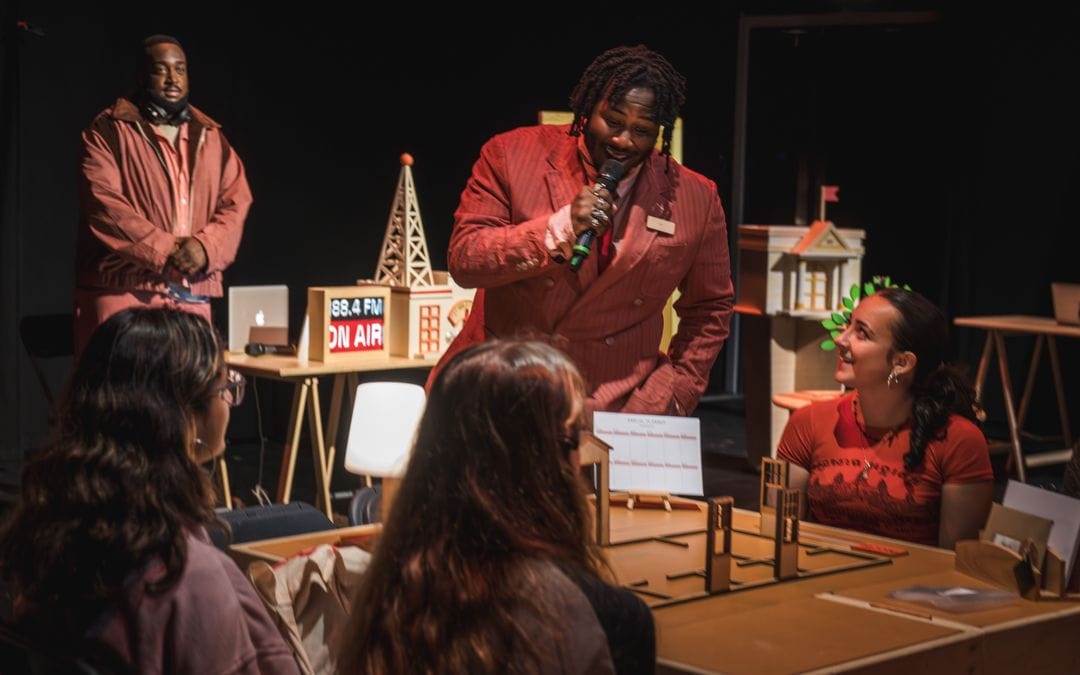
You may not have heard of the American Contemporary Ballet (ACB), but they’ve been here, right in your backyard, cooking up new shows for going on eight seasons. The Los Angeles-based ballet company have put on everything from an immersive version of The Nutcracker Suite to recreations of Fred Astaire’s most famous dances to examinations of how ballet works.
This Halloween season they’re offering a “Gothic horror” double feature of Burlesque and Inferno. They’re ready to send you on a journey to hell before letting you kick back at one of LA’s stranger burlesque clubs.
We spoke with the ACB’s artistic director and choreographer Lincoln Jones via email to learn more about the two shows.
This interview has been lightly edited for clarity.

No Proscenium (NP): In a nutshell, what are Burlesque and Inferno?
Lincoln Jones (LJ): Two ballets, the second of which is a world premiere, and quite unlike anything that has been on stage before.
Burlesque is a series of vignettes (like its eponymous source), each featuring a different dancer. The idea was to use the context of burlesque — sometimes an exhibitionistic display by a solo performer, sometimes a voyeuristic look into private moments — and some of the common tropes of burlesque, but to pair them with more substantial music, and the choreographic and opportunities that would provide.
Inferno is also a series of vignettes chosen from the poem. Charles [Wuorinen, the composer for the music in Burlesque and Inferno] chose his episodes exceptionally well, in terms of dance. Dante is repelled from the righteous path by three beasts (representing various vices). Beatrice, based on Dante’s real life unrequited love, tasks his hero, Virgil, with leading Dante through hell. From there they see the personages of the ancient Greece and Rome in Limbo, hear Paolo and Francesca tell their tragic story, see the monsters and giants of hell, encounter Satan, and escape through the center of the earth. I mean, Satan would obviously be an excellent dancer.
NP: Why the decision to pair them?
LJ: There were a lot of practical reasons: When I came up with the idea for Burlesque, I knew Charles was the man to compose it, and it made sense to pair it with the other ballet we currently perform to one of his existing scores. I had wanted a companion piece for Inferno anyway, because it is only about 30 minutes long. I also think Burlesque is really right for Halloween.
But in the completed ballets there is a more intangible connection which I think comes from the fact that I planned it as a companion piece from the beginning.
NP: What do you think makes Burlesque so right for Halloween?
LJ: These days, I think adult Halloween is primarily based on two elements: Gothic horror and sex. Burlesque definitely has both of those, but also goes beyond just those two elements. I didn’t plan the ballet to be about Gothic horror and sex, but those things are there to some degree. When I plan ACB programs that fall around cultural events like Halloween or Valentine’s day, I often think about what it is I would want to do at those times, or go see. Burlesque would definitely be on that list.
NP: Why are you interested in telling these stories right now?
LJ: I’ve actually had both of these ballets in mind for several years. It was more about the opportunity to finally do them. With Inferno, it was the music that attracted me, but I also love to celebrate Halloween, and I thought it was a great fit for that. Burlesque deals with themes that have been important to me for a long time.
NP: Would you mind touching on some of those themes, why they’re important to you, and why you wanted to work them into Burlesque in particular?
LJ: I don’t think it was a matter of wanting to work them in to Burlesque, but rather that Burlesque was a good thematic opportunity to work with them. Or that those themes shaped the idea to begin with. I’m finding I’m reticent to try to speak about the themes themselves, I think partially because I’m not sure if at this point I can speak about them as articulately, or as specifically as I can stage them.
Burlesque, though, also works as a metaphor for ballet in general. In really good ballet, you get to see the dancer revealed. Other than practical concerns of musicality and good composition, that is what I’m really going for in ballet: to find, develop, and reveal the dancer as much as possible. That is maybe the real gift of ballet. It’s kind of like what Harold Bloom said: The reason for reading is to know people. Imagine if there was a flower that was only going to bloom once, in one single specimen, for all time. I think almost everyone would rush to try and see it. That’s what a dancer is. She works her whole life to make her body a vehicle for her soul, and then puts it on display for us.
NP: And why are you interested in telling these stories through ballet?
LJ: It’s really more that ballet is the medium I like to work with, and so it’s just a matter of how to deal with various themes in ballet. But Burlesque really lends itself to ballet, since it is dance-based to begin with.
NP: What influenced each piece (other than Dante’s Inferno)?
LJ: Charles, for one, because the music is obviously a massive influence on the shape of the ballet. With Burlesque, it was largely my personal experiences, various favorite artistic influences from film, ballet, and theatre. It’s quite a personal ballet actually; in some ways perhaps the most “me” of anything I’ve done. And it was the first full musical score I’ve ever commissioned. Inferno is also quite influenced (like most of my work) by George Balanchine — several of his ballets in particular.
Get Kevin Gossett’s stories in your inbox
Join Medium for free to get updates from this writer.
SubscribeSubscribe
And, the dancers are always an influence. I create each role for specific dancers, and who they are shapes the roles quite a bit.
NP: What was your experience like creating these pieces?
LJ: It’s always simultaneously tremendously satisfying and frustrating. Satisfying, because I finally get to work with things that have been in my head for quite a while, see them take shape in reality, and see the dancers put themselves into it. It’s also satisfying because I always learn a lot. But it is frustrating because I am never where I want to be artistically, and always see what it could be as my craft improves.
NP: And what experience do you have in creating this type of performance?
LJ: I started ballet quite late, at 20, but I really threw myself into it, as well as the study of music, and started making choreography right away. And right from the beginning I started producing my own stuff. But even before that, in high school, when I was active in theatre, I started envisioning and putting together productions. My approach from the beginning was to go outside the conventional, and find ways to do exactly what I wanted to do, even if they’d never been done before. So I gathered a lot of experience through trial and error, and just figuring things out until they worked.
Also, every ballet I create informs every one after that. ACB is in its eighth season in L.A., so we’ve been producing a season’s worth of work for a number of years now.
LJ: The show isn’t strictly immersive (in the way most people think of immersive), but it does lack a traditional proscenium. Can you explain the decision to stage the show this way and what it means for the audience?
I like bringing ballet, which is an art form with a lot of history, into a space that feels of our own time. It is a bit immersive in the sense that with Inferno and Burlesque you are inside of the set, instead of just looking at it in front of you. And being on the 32nd floor of a skyscraper with a 360 degree view of the city matches ballet’s exalted aesthetic quite well. And I like working without a proscenium in general; everything feels more three-dimensional.
However, on opening night, October 12, we’re having our annual Hellraiser, and there will be an additional experience that is immersive in the traditional sense. For those who like immersive theatre, I recommend it.
NP: Your location is also unique, would you describe it as site-specific or could Burlesque and Inferno be performed elsewhere?
LJ: A little of both. The ballet could be moved into another location without losing its choreographic integrity, but we do make use of the space in ways that really enhance the experience. The location plus the ballet makes for quite a unique experience.
NP: Were the performances written with the space in mind or did you write the shows and then go looking for something unique?
LJ: We’ve been in this space for a while, so I had it in mind when I created it.
NP: What do you hope people take away from the experience?
LJ: I really don’t hope for a single takeaway. I think Balanchine said it very well when he said to a young choreographer. ‘People don’t come to the theatre to see you, the come to see themselves.’ And although there is a lot of me in this ballet, I hope I’ve crafted it in such a way that people can see themselves. That’s my goal.
NP: What influenced Charles Wuorinen’s score for each piece?
LJ: I wouldn’t presume to speak for Charles, but with Burlesque I told him what I had in mind structurally and thematically. But Charles is not the type of composer who’s going to create to a load of detailed specifications; he takes the thing and makes it his own. But that’s what I wanted, because I love his music.
For Inferno, I think his interest lay partly in the numerical underpinnings of the poem and the William Blake illustrations, which also were an inspiration for me.
NP: When Inferno was written, it was very much of the time and dealt with political and religious figure of the day, as well as historical figures. Did you try and update those allegorical elements, or do they remain as Dante wrote them?
LJ: My main interest was in trying to do the score as much justice as possible, but I think my approach was to try to deal with universals more than focusing on any specific time period.
NP: Are there any challenges in creating new ballet pieces and scores when that’s maybe more “classical” than people are accustomed to?
LJ: In my view, the ‘classical’ approach is simply an attempt to use all the resources at one’s disposal. Good dance can be hard to make, but if you achieve it, I think it has a universal appeal. Everyone dances. I think probably anyone from just about any time or culture can appreciate Fred Astaire, and I think that is because he was such a dancer…not about tricks, or a particular enshrined vocabulary, but just a phenomenal musicality. I think if you can get close to that, it doesn’t matter if it is ‘classical’ or not.
Burlesque & Infero runs October 12— 31 in Downtown Los Angeles. Tickets are $45–500.
NoPro is a labor of love made possible by:

…and our generous Patreon backers: join them today!
In addition to the No Proscenium web site, our podcast, and our newsletters, you can find NoPro on Twitter, Facebook, YouTube, Instagram, in the Facebook community Everything Immersive, and on our Slack forum.





















Discussion